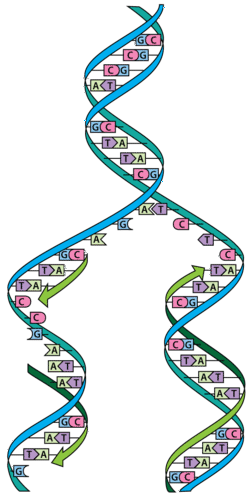3.17: DNA Structure and Replication
- Page ID
- 3016
Does DNA copy itself?
Yes, your DNA needs to copy itself every time a new cell is created. The new cell needs to have DNA exactly like the rest of your cells. Otherwise, that cell might malfunction. That's why it's important that the process of copying DNA, called DNA replication, is very accurate.
DNA Replication
DNA must replicate (copy) itself so that each resulting cell after mitosis and cell division has the same DNA as the parent cell. All these cells, the parent cell and the two new daughter cells, are genetically identical.
DNA replication occurs during the S phase (the Synthesis phase) of the cell cycle, before mitosis and cell division. The base pairing rules are crucial for the process of replication. DNA replication occurs when DNA is copied to form an identical molecule of DNA.
The general steps involved in DNA replication are as follows:
- The DNA helix unwinds like a zipper as the bonds between the base pairs are broken. The enzyme DNA Helicase is involved in breaking these bonds.
- The two single strands of DNA then each serve as a template for a new stand to be created. Using DNA as a template means that on the new strand, the bases are placed in the correct order because of the base pairing rules. Recall that A and T are complementary bases, as are G and C. As a template strand is read, the new strand is created. If ATGCCA is on the "template strand," then TACGGT will be on the new DNA strand. The enzyme DNA Polymerase reads the template and builds the new strand of DNA.
- The new set of nucleotides then join together to form a new strand of DNA. The process results in two DNA molecules, each with one old strand and one new strand of DNA.
This process is known as semiconservative replication because one strand is conserved (kept the same) in each new DNA molecule (Figure below).

Summary
- During DNA replication, the DNA helix unwinds and the two single strands of DNA then each serve as a template for a new stand to be created.
- DNA replication is semi-conservative: the new DNA molecule consists of half of the parent DNA molecule.
Explore More
Use the resource below to answer the questions that follow.
- DNA replication at http://www.youtube.com/watch?v=yqESR7E4b_8 (7:47)
- What protein molecules does DNA wrap around to form a nucleosome?
- What makes up chromatin?
- When can you see chromosomes in a cell?
- Are both strands of DNA copied continuously during replication? Explain your answer.
Review
- Describe how DNA is replicated.
- Explain why DNA replication is sometimes called semiconservative.


